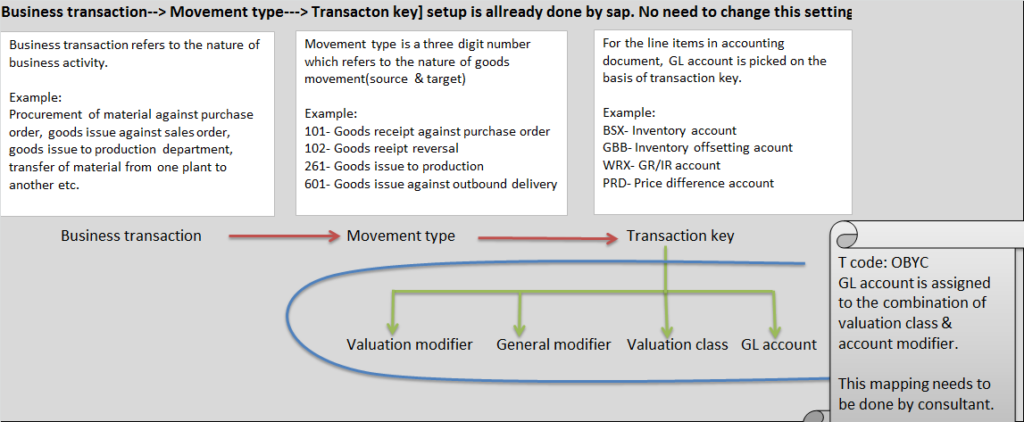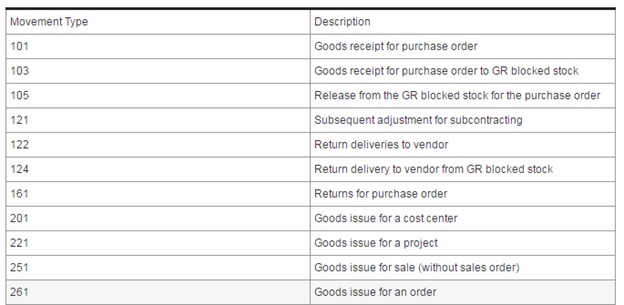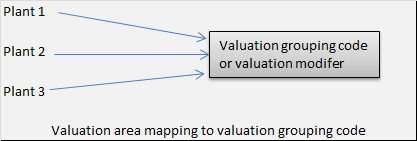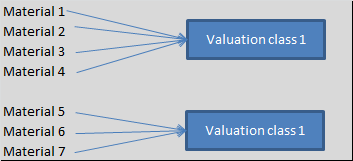
When good receipt (GR) and invoice receipt (IR) is performed, accounting document gets generated. Movement of material leads to automatic generation of accounting document and this is referred as MM FI integration.
Question is how system determines which accounts to debit and which accounts to credit?
Let’s understand MM FI integration

Movement type:
It’s a three digit number which represents the nature of movement of material.
Movement types are predefined by sap. Depending upon transaction, sap automatically picks the corresponding movement type.
Below shows few examples of movement types:

Transaction key:
GL account is determined with the help of transaction key.
Below are few examples:
BSX : Inventory account (helps in determining GL account for inventory)
GBB : inventory offsetting account (helps in determining offsetting GL account of inventory GL account)
WRX : GR/IR clearing account (helps in determining GR/IR clearing account)
PRD : Price difference account (helps in determining GL account for booking any difference in prices)
Valuation modifier:
Valuation areas are grouped together and this group is known as valuation modifier or valuation grouping code.
Valuation area is basically the level at which material is valued. Material can be valued either at plant level or at company code level. Hence valuation area is either plant or company code.
Consider a scenario; a company code has 3 plants.
If valuation area is set as company code, then the price of material in all 3 plants will be same and material in all 3 plants will be posted to same set of GL accounts.
If valuation area is set as plant, then material price in each plant can be different and material can be maintained using a separate set of GL accounts.
Standard practice is to keep valuation area as plant.
If multiple plants to use the same set of GL accounts, then valuation areas (plants) can be grouped together. GL account to be mapped to this group in OBYC.

Benefit of using valuation grouping code or valuation modifier is reduced number of entries to be maintained in OBYC.
Using valuation modifier is optional. Depending upon business requirement it may or may not be used in account determination.
General modifier
General modifier is used only with three transaction keys (GBB, PRD & KON)
General modifier help to post to different GL accounts with the same transaction key.
Valuation class:
Valuation class is used in automatic account determination.
Valuation class is maintained in material master.

Lorem ipsum dolor sit amet, consectetur adipiscing elit. Ut elit tellus, luctus nec ullamcorper mattis, pulvinar dapibus leo.
Let's take an example and understand above concept:
From the nature of business transaction, system automatically determines the material movement type involved.
From movement type, system automatically determines the transaction key and general modifier involved in posting the accounting document.
The material involved in the transaction belongs to a particular plant. From plant, valuation modifier is identified.
From material master, valuation class is identified. (Every material is assigned to a valuation class and this assignment is done in materiel master)
Now system searches for combination of valuation modifier, general modifier, valuation class and mapped GL account. This combination is maintained in T code OBYC.
Example:
When goods receipt (GR) is posted against purchase order (PO), System automatically determines that movement type 101 is involved.
From movement type 101, system knows transaction key involved is BSX, WRX & PRD.
From movement type, account modifier if involved is identified.
From plant, valuation modifier is identified.
From material, valuation class is identified.
Below accounting entry is posted:
DR. Inventory account (GL account mapped under transaction key BSX)
CR. GR/IR clearing account (GL account mapped under transaction key WRX)
DR/CR. Price difference account (GL account mapped under transaction key PRD)
GL ACCOUNTING
- What is SAP FICO ?What business requirement is fulfilled in this module?
- What is enterprise structure in sap fico?
- What is GL account? What is account group? What is operational chart of accounts?
- What is the need of country chart of account or alternate chart of account? How country chart of account helps fulfill a business requirement?
- What is the need for group chart of account? How group chart of account helps in consolidation of financial data?
- What is non leading ledger in sap fico?
- What is company code global settings? What global parameter is assigned to company code?
- What is fiscal year variant? Why fiscal year variant is assigned to company code?
- What is posting period variant? Why posting period variant is assigned to company code?
- What is field status variant? What is field status group?
- What is document type in sap? Explain the purpose of document type?
- Document date vs Posting date vs Entry date vs Translation date. Explain
- What is posting key? what is the use of posting key?
- Document header & line items capture information of business transaction.
- Everything about currency & exchange rate in sap.
- Foreign currency valuation in sap. Explain with example
- Retained earnings account helps in year end balance carry forward. Explain
- What is the significance of tolerance groups in sap?
- What parameters are maintained in GL master and how does it impact in document posting?
ACCOUNTS PAYABLE
- What is meant by accounts payable in sap?
- Understanding procure to pay (PTP) cycle and accounting document at each step.
- Understanding MM FI integration in very simple terms.
- Purchase order price determination in SAP. Explained in very simple words.
- House bank, Bank key, Account ID in SAP
- What configuration (FBZP) needed for executing F110 in sap ?
ACCOUNTS RECEIVABLE
- How sap overcomes challenges in accounts receivable process?
- What is customer reconciliation account?
- Understanding order to cash cycle in sap.
- Understanding SD FI integration in very simple terms.
- What is lock box? How lockbox helps in collection from customers?
TAX ACCOUNTING
- How sap helps in tax accounting?
- Tax configuration in sap: Tax procedure, Tax code & Tax jurisdiction code
- Concept of tax jurisdiction code & tax jurisdiction structure
- Significance of “Tax category & Posting without tax allowed” in GL master.
- Tax base amount and Discount base amount
- Assigning tax code V0 & A0 for non taxable transaction?
- Deductible input tax vs non deductible input tax
WITHHOLDING TAX
- Withholding tax in sap explained with example.
- How sap overcomes challenges in managing withholding tax?
- Withholding at the time of invoice or payment
- Withholding tax configuration in sap
- Business place & Section code in sap
- Withholding tax certificate numbering in sap
- Withholding tax report for filling tax returns
ASSET ACCOUNTING
- How sap helps in asset accounting?
- What is meant by asset accounting?
- What is the use of asset class?
- What is the use of depreciation key in asset accounting?
- Depreciation area and Chart of depreciation in sap.
- Derived depreciation area VS real depreciation area?
- Understanding asset accounting configuration needed in sap
- GL account determination for posting asset transaction
- Asset transaction and corresponding accounting document?
- How depreciation is posted in sap?
SAP CONTROLLING